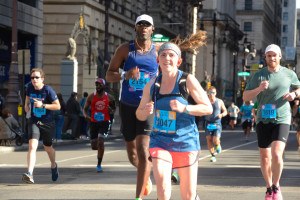10 Lessons from a Broad Street Run Newbie

Ashley’s view from the starting line.
It’s been a long time since I’ve been called a virgin, but there I was, in my corral at yesterday’s Broad Street Run, doing something for the first time ever: this race—and any race, for that matter. Now that I’ve popped my Broad Street cherry (with the help of 40,000 others), I’ve learned a few things.
Here, my 10 biggest Broad Street lessons.
1. All the logistical stuff is totally worth stressing about.
In the weeks leading up to the race, I didn’t even think about the actual run. I was worried— alright, obsessed—with all the other stuff: What time should I catch the train? Shorts or running tights? What should I eat and when? Coffee? Bathrooms? While I’ve never run another local road race, I can’t imagine another one being as much of a cluster to get to as this one is. You basically have one option, taking the Broad Street line, which is filled with 39,999 other people doing the same thing. Stressing about it means that you are thinking through all the potential pitfalls, honing in on your morning-of routine, and talking to a lot of people about best practices. All of my research led to an almost (see #5) ideal morning. (The fact that my subway broke down TWICE is something I can’t control.) I got on a train around 7:20. That got me to my corral around 8:00. Getting there earlier probably means less crowds, but it’s not necessary.
2. All of the hard core training is totally not worth stressing about.
Yes, this is more than a 5K, and while 10 miles is a huge accomplishment, and the most I’ve ever run, this is not a marathon. Due to a full-time job, Satan’s winter, and a toddler, I only managed two runs, at most, each week in the 12 weeks I trained, and weight workout one other day. A wise friend (and seasoned runner) told me that if you can get past four miles, you can run 10. And he was right. I slowed down at the end, but it was totally doable. You can’t really really wing a marathon, but if you run a few days a week, and get past that four-to-six-mile hump, you can totally do this race. This isn’t some hard-core mud run … and the vibe, while not flippant, is still fun (there are people in tutus). My point: This is a great run for those who are new to running.
3. Shave a few seconds off your minute-per-mile time when signing up.
Race day adrenaline, the marching bands, and the herd of people will push you forward faster than on any training run you did. When you enter the lottery, you have to say what your minute-per-mile time is. This time determines your starting position. Underestimate and you’ll get a better starting position—and one that’s more accurate for race day.
4. Break the rules #1: You can wear headphones
The race rules say you can’t. Everyone does. I can’t run without my music and was happy I did. Just keep the music low so you can hear all the cheering (and passing runners).
5. Break the rules #2: There’s more time at the starting line than you think.
The race starts at 8:30 a.m., but it takes a while to get 40,000 people through the starting line. Pre-race communications are clear: Be in your corral at 8:10. I agree that this is a good idea. But if you need to hit the Porta Potties and wait on the long ass lines, you have time to do so. My corral didn’t actually start moving towards the starting line until 8:40. I waited in my corral for 30 minutes instead of waiting in a line for the bathroom. (You see where I’m going with this right?)
6. Don’t bring anything you can’t carry while you run.
There is this rather elaborate, and fairly organized-looking, gear-check system that involves buses and tickets. This is just one more thing to stress about, and one more thing that takes up time from waiting on bathroom lines. It’s only 10 miles; there isn’t really anything in this world that you need to bring with you. Food and water can be consumed or thrown away before the race starts. Your phone can be strapped to your arm with a band. Invest in shorts with a zipper, or one of those fanny pack-like Spibelts. Tie any long-sleeve shirts around your waist or toss them. (They get collected for charity.) At the finish line there is cold water and tons of free food. Trust me, after the run, and the crowds at the finish line, you won’t want to have to wait for your stuff … again.
7. Start the race in the middle of the street.
You can’t totally predict where Mayor Nutter will be standing to hand out high-fives to runners as you cross the starting line, but if you’re in the middle, you have a better chance of moving around (okay, just a tiny bit) to find him, if you really want a Nutter high-five. Also, the middle of the road is the flattest for most of the race—the road sort humps in the middle and tapers to the left and right, which can throw your legs out of whack. Stick to the middle when you can.
8. Know that you’ll have to walk a mile or so to get back to the subway.
And it’s packed with people. (Smelly people, too.)
9. You should tell everyone you are running.
I’m a pretty under-the-radar person when it comes to my personal life, but I found that everyone I told (co-workers, the running store guys, friends) was only super cheery about the fact that I was running. I fed off that energy in the few days leading up to the race—something that’s totally part of the experience.
10. Take it all in.
When my friend, April, moved to Boston a few months ago, she told me that running Broad Street was one of her top Philly experiences in the 18 years she lived here. I couldn’t agree more. It’s up there with the 2008 World Series win. Being part of such a positive and uniquely Philadelphia experience, that is both collective and yet utterly personal, makes for a rare combination of emotions. So make sure to go at a pace where you can really enjoy all the fans, all the runners, and the once-a-year perspective of our city’s most famous street.
»What were your biggest takeaways from this year’s run, Broad Streeters? Whether your a veteran or a newbie, we want to hear about your experience. Share in the comments.
Like what you’re reading? Stay in touch with Be Well Philly—here’s how:
- Like Be Well Philly on Facebook
- Follow Be Well Philly on Twitter
- Follow Be Well Philly on Pinterest
- Get the Be Well Philly Newsletter


